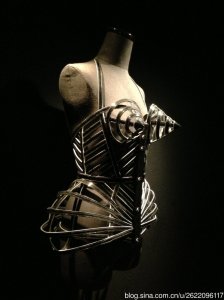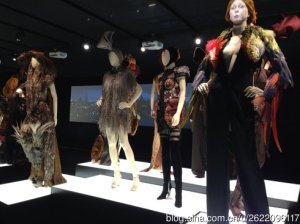Between June 15 and September 22, 2013, the Swedish Centre for Architecture and Design presented the first international exhibition on the masterpieces of the legendary French designer Jean Paul Gaultier, named “The Fashion World of Jean Paul Gaultier: From the Sidewalk to the Catwalk”. This exhibition was organized by the Montreal Museum of Fine Arts in collaboration with the Maison Jean Paul Gaultier and would travel to various cities. Most of these pieces were exhibited for the first time in Sweden, including Fashion show recordings, television programmes, films, videos, sketches and photographs by leading artists or photographers as Andy Warhol, David LaChapelle and Cindy Sherman complete the world of Gaultier.
As a fashion scholar, of course I know the big name of Gaultier. He launched his first prêt-à-porter collection in 1976 and founded his own couture house in 1997. His avant-garde fashions showed an understanding of a multicultural society, questioning the traditional mainstream aesthetic values.
I was quite impressed by the exhibition, as it was one of the most high tech fashion exhibitions that I have ever visited. It featured 120 ensembles and numerous documents, which were grouped into different theatrical themes. The animated mannequins were so lively with their eye twinkling. The facial expressions were projected from small equipments high in the hall. Besides, multimedia technology made them singing and speaking as well.
This exhibition presents a long journey of Gaultier’s design. His inspiration came out of the enthusiasm towards life and various kinds of beauty. During this journey, he has built his own aesthetics, which shows his vision of diversity and democracy. The exhibition contains six themes: The Odyssey of Jean Paul Gaultier, introducing the designer’s life and generalizing the key features of Haute couture; the Boudoir, Skin Deep, Punk Cancan, Urban Jungle, and Metropolis. Through the tremendous ensembles, we entered into a special sexual and dramatic world.
Fashion is traditionally considered to function as a source of sexual appeal to the opposite gender. This exhibition tells us that in Jean’s world, sexuality is expressed through corset, the patterns of human bodies and animal inspired design.
First, corset was the major part of the collections. Famous fashion scholar Valerie Steele has written a thick book of culture history of corset. In fashion history, corset plays an important role of creating artificial proportion upon female body according to a male gaze. It was considered to be social oppression over women, thus being abandoned with the development of society. In recent years, corset reappeared in fashion, “transformed from underwear to outwear”, but it became popular mostly in subculture styles. Long exiled from mainstream fashion, the corset continued to exist in the fetishistic pornography, which was associated with “the powerful Phallic Woman” and “the sexual ‘perversions’ of sadomasochism and transvestism”(Steele, 2001:165).Later, corset is becoming adopted by people in Punk and Goth subculture, who makes it as ‘a symbol of rebellion and sexual perversity’(Steele, 2001:166) Fashion designer Jean-Paul Gaultier is known for “subverting the clichés of masculinity and femininity through parodic exaggeration as well as for “emphasizing sexuality through the use of fetishized garments, and has made the corset an integral part of his work”(Steele, 2001:167). Popular culture and media helped popularizing his corset design, such as Madonna, who was instrumental in doing so. This exhibition presented a large quantity of corsets throughout the whole six themes and photography as well, including photography of Madonna’s wearing Jean’s designed corsets.
Second, naked human body could be seen as prints in some designs. Genital organs of men and woman were particularly obviouson fabrics. This is not real nakedness, but a secondary reality: an image. The naked human body is morally forbidden in most social circumstances, but here transformed into a code or a sign, which symbolizes nudity and shows an irony of it. This design represents a postmodernist idea of carnival, where everything becomes an expression, a visual game or a sign.
Last but not least, sexiness is also shown in the interests to wildness and animals. Animal prints have already been a hot trend seen on garments and accessories for some time, symbolizing exotic lure. In this exhibition, the theme of Jungle shows this kind of sexiness, arisen from wildness, primitiveness and exotic life etc. The designs on the central stage of this hall display a fetish of fur and animal prints, making the models as camouflaged animals not in the nature but in the urban city.
Reference
Steele, Valerie (2001). The corset: a cultural history . New Haven: Yale University Press




